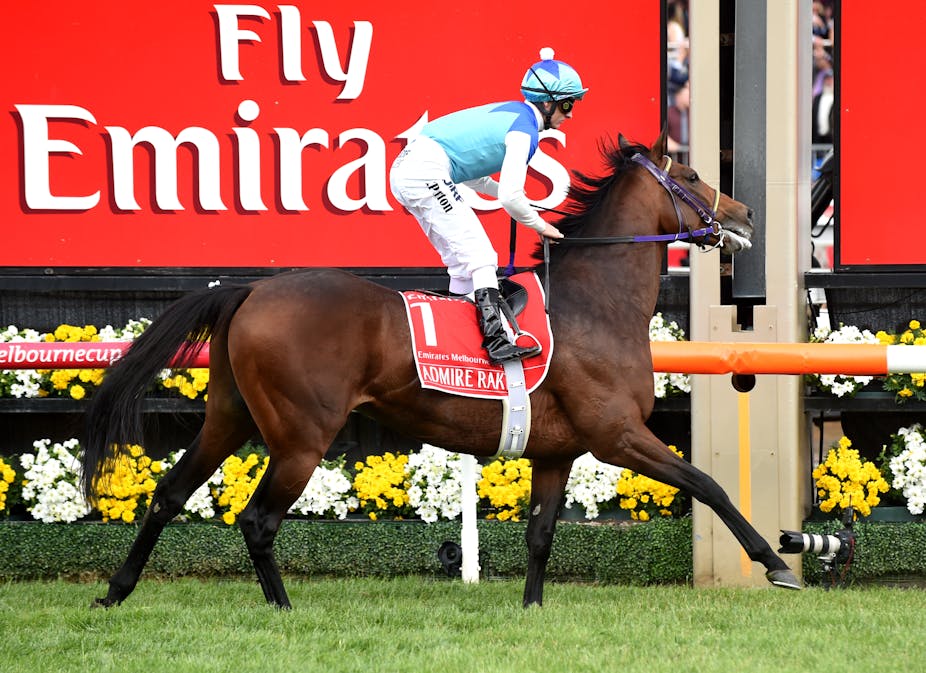The tragic deaths of the favourite Admire Rakti and seventh placegetter Araldo soon after the Melbourne Cup has focused attention on some of the risks involved in racing horses.
The Japanese horse Admire Rakti died from acute heart failure soon after the end of the race, according to reports of a post-mortem examination.
Racing Victoria is now considering changes to the way horses are returned to the mounting yard after Araldo fractured a bone after he was “frightened” by a spectator who raised a flag.
The horse received immediate veterinary care but the fracture was not repairable and the horse was later euthanised.
Horses are large and powerful animals with a sensitive and explosive flight response to perceived danger which puts them by nature at risk of injury and even death at any time whether they are racing or left alone in a paddock.

Unlike other areas of the horse industry, the high profile of horse racing and intense interest in the spring carnival means that injuries and deaths of racehorses on the track are in the public spotlight.
Horse racing in Australia is a highly regulated industry, and detailed data is collected for all adverse incidents on racetracks. This data is used by researchers and racing authorities to track trends and investigate risk factors that may be modified in order to prevent further injuries and deaths.
Similar data for horses not involved in racing is generally difficult to obtain and attracts little research interest. Although it seems likely that racing horses increases the risk of death, the magnitude of this difference is not known.
Sudden deaths are rare
Because of careful data collection we know that the rate of sudden deaths on Victorian Thoroughbred racetracks over the past ten years is 0.06 per 1,000 flat race starts. This equates to one to two sudden deaths per year in Victoria.
The rate of limb injuries in flat racing resulting in euthanasia on Victorian race tracks over the same period is 0.4 per 1,000 starts.
Many limb injuries in racehorses can heal with time or be repaired with surgery but recovery depends on the severity of the injury. Complex fractures, where stability of the limb is lost, may not be repairable because horses need to be able to bear full weight on all four limbs immediately following surgery and this can be difficult or impossible to achieve.
The cause of sudden death in a racehorse can be difficult to determine. All horses that die on metropolitan tracks in Victoria undergo an autopsy routinely.
But even with a detailed post-mortem examination, discovering the cause of death can be challenging. It is possible to find the cause of death in about 50% of cases, but in the remainder the cause is unclear.

Commonly identified causes of sudden deaths include bleeding into the lungs – Exercise Induced Pulmonary Haemorrhage (EIPH) – and heart failure.
Bleeding into lungs occurs when the thin membrane separating the blood in the capillaries from the air in a lung’s small air sacs ruptures.
This is thought to occur as a result of the extremely high pressure generated within the pulmonary capillaries in order to meet the muscles’ demands for oxygenated blood during exercise. A small amount of haemorrhage has little effect on the horse but a large amount can have serious consequences.
It is for this reason that when blood is observed coming out of the nostrils, affected horses are excluded from racing.
Heart failure in racing
Much less is known about the causes of heart failure in horses during racing. Although these events are often termed “heart attacks”, they are likely to be quite different from heart attacks in people.
The nature of horses is such that anything we do with them is inherently risky, including racing.
Risks to racehorses are mitigated by close monitoring of horse health by regulatory veterinarians, detailed investigation of incidents when they occur, ongoing research into injury prevention and education of industry participants.
In Australia the risks are relatively low but we need to strive to lower these risks even further. Every death of a racehorse is a tragedy, but one from which we need to learn.

